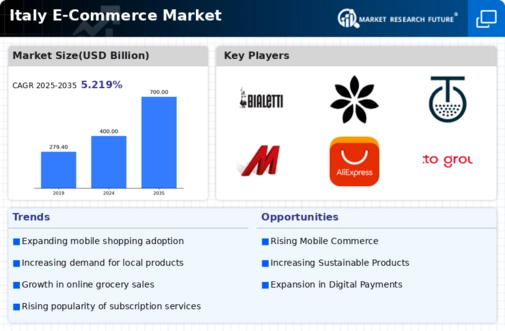Digital Payment Innovations
The rise of digital payment solutions is transforming the e commerce market in Italy. With the increasing adoption of mobile wallets and contactless payment methods, consumers are experiencing enhanced convenience and security. In 2025, it is estimated that over 60% of online transactions in Italy will be conducted through digital payment platforms. This shift not only streamlines the purchasing process but also encourages higher spending, as customers are more likely to complete transactions when payment methods are user-friendly. Furthermore, the integration of advanced security features, such as biometric authentication, is likely to bolster consumer confidence in online shopping. As a result, the e commerce market is poised for substantial growth, driven by these innovations in payment technology.
Mobile Optimization Strategies
The importance of mobile optimization in the e commerce market cannot be overstated. With a significant portion of online shopping conducted via smartphones, businesses are prioritizing mobile-friendly websites and applications. In Italy, it is projected that mobile commerce will account for over 50% of total e commerce sales by the end of 2025. This shift necessitates that companies invest in responsive design and seamless user experiences to cater to mobile users. Additionally, the rise of mobile apps is likely to enhance customer engagement and retention. As the e commerce market adapts to these mobile trends, the potential for increased sales and customer satisfaction appears promising.
Logistics and Delivery Enhancements
Efficient logistics and delivery systems are crucial for the e commerce market in Italy. The demand for faster delivery options is increasing, with consumers expecting their orders to arrive within 24 to 48 hours. In response, many e commerce businesses are investing in advanced logistics solutions, including automated warehousing and last-mile delivery services. According to recent data, approximately 70% of Italian consumers consider delivery speed a key factor in their online shopping decisions. This emphasis on logistics not only improves customer satisfaction but also enhances the overall competitiveness of the e commerce market. As companies continue to innovate in this area, the potential for growth remains significant.
Personalization and Customer Experience
Personalization is becoming a cornerstone of the e commerce market in Italy. Businesses are increasingly leveraging data analytics to tailor shopping experiences to individual preferences. This trend is evident as approximately 80% of consumers express a preference for personalized recommendations. By utilizing customer data, e commerce platforms can enhance user engagement and drive sales. Moreover, the integration of AI-driven chatbots and virtual assistants is likely to improve customer service, providing instant support and recommendations. As the e commerce market continues to evolve, the focus on personalization may lead to higher conversion rates and customer loyalty, ultimately contributing to sustained growth.
Regulatory Compliance and Data Protection
As the e commerce market in Italy expands, regulatory compliance and data protection are becoming increasingly critical. The implementation of stringent data protection laws, such as the General Data Protection Regulation (GDPR), has necessitated that businesses prioritize consumer privacy and data security. In 2025, it is anticipated that compliance with these regulations will be a key factor influencing consumer trust in online shopping. Companies that demonstrate a commitment to safeguarding customer information are likely to gain a competitive edge in the e commerce market. Furthermore, as consumers become more aware of their rights regarding data protection, businesses must adapt their practices to meet these expectations, potentially driving further growth in the sector.























Leave a Comment